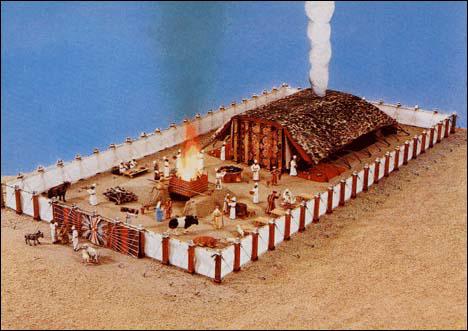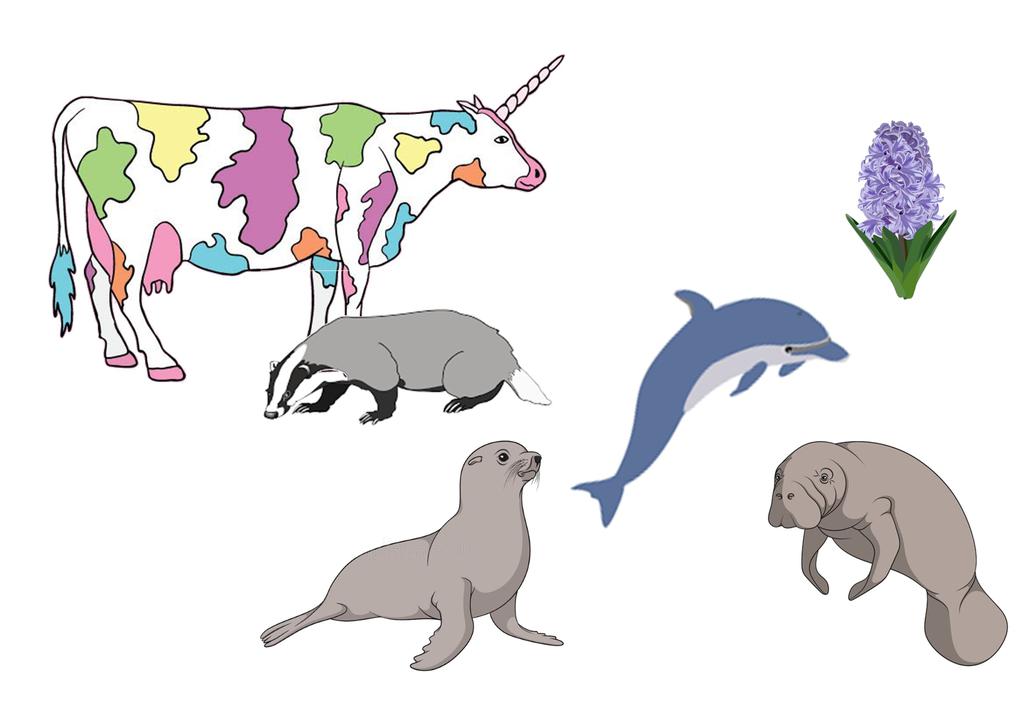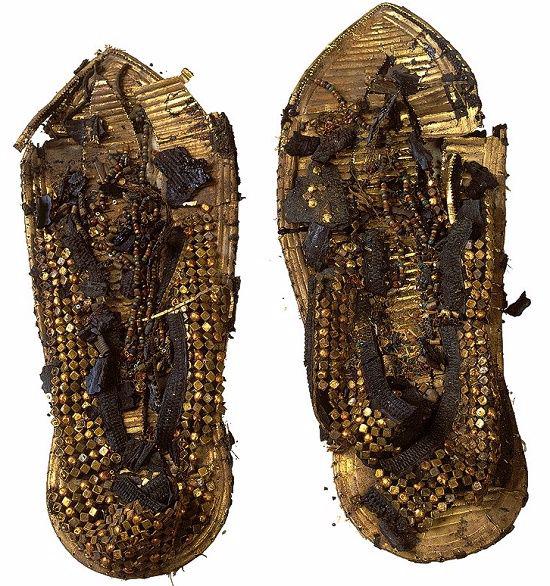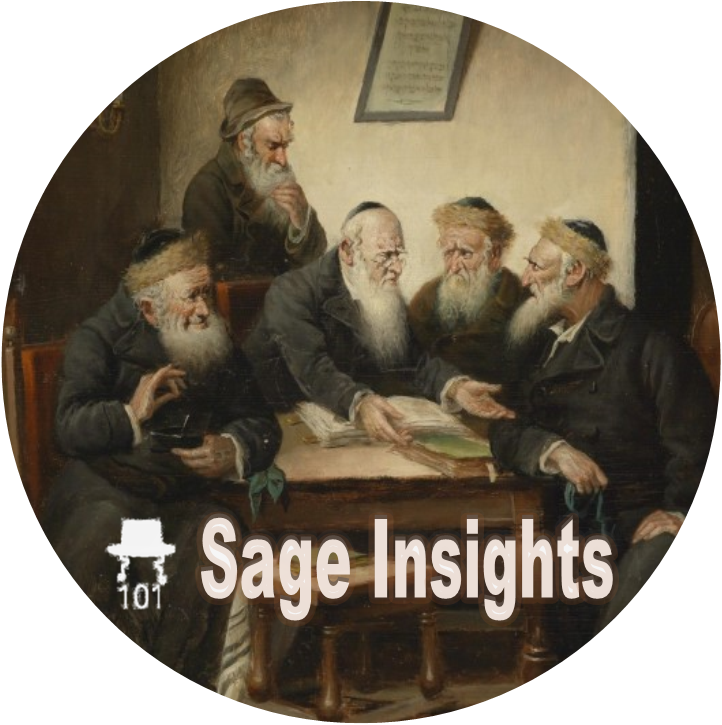- מגדל (migdal): a place of greatness; i.e. tower
- מדרש (midrash): a place of seeking; i.e. commentary on Scripture
- משלח (mishlach): the place of casting away, i.e. forgiveness

(א) כאשר דבר השם עם ישראל פנים בפנים עשרת הדברות, וצוה אותם על ידי משה קצת מצות שהם כמו אבות למצותיה של תורה, כאשר הנהיגו רבותינו עם הגרים שבאים להתיהד (יבמות מז:), וישראל קבלו עליהם לעשות כל מה שיצום על ידו של משה, וכרת עמהם ברית על כל זה, מעתה הנה הם לו לעם והוא להם לאלהים כאשר התנה עמהם מתחלה ועתה אם שמוע תשמעו בקולי ושמרתם את בריתי והייתם לי סגולה (שמות י״ט:ה׳), ואמר ואתם תהיו לי ממלכת כהנים וגוי קדוש (שם יט ו), והנה הם קדושים ראוים שיהיה בהם מקדש להשרות שכינתו ביניהם ולכן צוה תחלה על דבר המשכן שיהיה לו בית בתוכם מקודש לשמו, ושם ידבר עם משה ויצוה את בני ישראל:
והנה עקר החפץ במשכן הוא מקום מנוחת השכינה שהוא הארון, כמו שאמר (שמות כ״ה:כ״ב) ונועדתי לך שם ודברתי אתך מעל הכפרת, על כן הקדים הארון והכפרת בכאן כי הוא מוקדם במעלה, וסמך לארון השלחן והמנורה שהם כלים כמוהו, ויורו על ענין המשכן שבעבורם נעשה אבל משה הקדים בפרשת ויקהל את המשכן את אהלו ואת מכסהו (שמות ל״ה:י״א), וכן עשה בצלאל (שמות ל״ו:ח׳), לפי שהוא הראוי לקדם במעשה: וסוד המשכן הוא, שיהיה הכבוד אשר שכן על הר סיני שוכן עליו בנסתר וכמו שנאמר שם (שמות כ״ד:ט״ז) וישכן כבוד ה' על הר סיני, וכתיב (דברים ה כא) הן הראנו ה' אלהינו את כבודו ואת גדלו, כן כתוב במשכן וכבוד ה, מלא את המשכן (שמות מ׳:ל״ד). והזכיר במשכן שני פעמים וכבוד ה' מלא את המשכן, כנגד ''את כבודו ואת גדלו,; והיה במשכן תמיד עם ישראל הכבוד שנראה להם בהר סיני. ובבא משה (שמות ל״ד:ל״ד) היה אליו הדבור אשר נדבר לו בהר סיני. וכמו שאמר במתן תורה (דברים ד לו) מן השמים השמיעך את קולו ליסרך ועל הארץ הראך את אשו הגדולה, כך במשכן כתיב (במדבר ז פט) וישמע את הקול מדבר אליו מעל הכפרת מבין שני הכרובים וידבר אליו:
ונכפל ''וידבר אליו'' להגיד מה שאמרו בקבלה שהיה הקול בא מן השמים אל משה מעל הכפרת ומשם מדבר עמו' כי כל דבור עם משה היה מן השמים ביום ונשמע מבין שני הכרובים, כדרך ודבריו שמעת מתוך האש (דברים ד לו), ועל כן היו שניהם זהב וכן אמר הכתוב (להלן כט מב מג) אשר אועד לכם שמה לדבר אליך שם ונקדש בכבודי, כי שם יהיה בית מועד לדבור ונקדש בכבודי: והמסתכל יפה בכתובים הנאמרים במתן תורה ומבין מה שכתבנו בהם (עי' להלן פסוק כא) יבין סוד המשכן ובית המקדש, ויוכל להתבונן בו ממה שאמר שלמה בחכמתו בתפלתו בבית המקדש, ה', אלהי ישראל (מלכים א ח׳:כ״ג) ' כמו שאמר בהר סיני ויראו את אלהי ישראל (שמות כ״ד:י׳), והוסיף שם לפרש ''ה'''לענין שרמזנו שם למעלה כי אלהי ישראל יושב הכרובים (מלכים א ח כג), כמו שאמר וכבוד אלהי ישראל עליהם מלמעלה היא החיה אשר ראיתי תחת אלהי ישראל בנהר כבר ואדע כי כרובים המה (יחזקאל י יט כ) ואמר דוד ולתבנית המרכבה הכרובים זהב לפורשים וסוככים על ארון ברית ה' (דהי''א כח יח), וכן יזכיר תמיד בבית המקדש לשם ה, (מלכים א ה׳:י״ט), לשמך (שם ח מד), ויאמר בכל פעם ופעם ואתה תשמע השמים (שם ח לב), במדת רחמים, וכתיב (שם ח מד מה) והתפללו אל ה' דרך העיר אשר בחרת בה והבית אשר בניתי לשמך ושמעת השמים, ובביאור אמר כי האמנם ישב אלהים את האדם על הארץ הנה שמים ושמי השמים לא יכלכלוך (דהי''ב ו יח). וכתיב על הארון להעלות משם את ארון האלהים אשר נקרא שם שם ה' צבאות יושב הכרובים עליו (שמואל ב ו׳:ב׳). ובדברי הימים (א יג ו) להעלות משם את ארון האלהים ה' יושב הכרובים אשר נקרא שם, כי השם יושב הכרובים:
(1) Now that G-d had told Israel face to face the Ten Commandments, and had further commanded them through Moses some of the precepts which are like general principles to the [individual] commandments of the Torah — in the same way that our Rabbis were accustomed to deal with strangers who come to be converted to the Jewish faith — and now that the Israelites accepted upon themselves to do all that He would command them through Moses and He made a covenant with them concerning all this, from now on they are His people and He is their G-d This is in accordance with the condition He made with them at the beginning: Now, therefore, if ye will indeed hearken unto My voice, and keep My covenant, then ye shall be Mine own treasure, and He said further: and ye shall be unto Me a kingdom of priests, and a holy nation. They are now holy, in that they are worthy that there be amongst them a Sanctuary through which He makes His Divine Glory dwell among them. Therefore He first commanded concerning the Tabernacle, so that He have amongst them a house dedicated to His name, from where He would speak with Moses and command the children of Israel. Thus the main purpose of the Tabernacle was to contain a place in which the Divine Glory rests, this being the ark, just as He said, And there will I meet with thee, and I will speak with thee from above the ark-cover. Therefore He first gave the commandment about the ark and the ark-cover, for they are first in importance. Next to the ark He gave the commandment about the table and the candelabrum, which are vessels just like the ark, and because they indicate the purpose for which the Tabernacle was made. Moses, however, preceded to mention in the section of Vayakheil: the Tabernacle, its Tent, and its covering, and in that order Bezalel made them [first the Tabernacle and then the ark], because from the practical end it is proper to build the house first [and then make its vessels].
The secret of the Tabernacle is that the Glory which abode upon Mount Sinai [openly] should abide upon it in a concealed manner. For just as it is said there, And the glory of the Eternal abode upon Mount Sinai, and it is further written, Behold, the Eternal our G-d hath shown us His glory and His greatness, so it is written of the Tabernacle, and the glory of the Eternal filled the Tabernacle. Twice is this verse, and the glory of the Eternal filled the Tabernacle mentioned in connection with the Tabernacle, to correspond with His glory and His greatness. Thus Israel always had with them in the Tabernacle the Glory which appeared to them on Mount Sinai. And when Moses went into the Tabernacle, he would hear the Divine utterance being spoken to him in the same way as on Mount Sinai. Thus just as it is said at the Giving of the Torah: Out of heaven He made thee to hear His voice, that He might instruct thee; and upon earth He made thee to see His great fire, so it is written of the Tabernacle, and he heard the voice speaking unto him from above the ark-cover…from between the two cherubim; and He spoke unto him. The expression “speaking unto him” is mentioned here twice in order to indicate that which the Rabbis have said in the Tradition that the Voice would come from heaven to Moses from upon the ark-cover, and from there He spoke with him; for every Divine utterance with Moses came from heaven during daytime, and was heard from between the two cherubim, similar to what is said, and thou didst hear His words out of the midst of the fire. It is for this reason that the two cherubim were made of gold. And Scripture so states: where I will meet with you, to speak there unto thee; and it shall be sanctified by My glory, for there [in the Tabernacle] will be the appointed place for the Divine utterance, and it will be sanctified by My glory.
Now he who looks carefully at the verses mentioned at the Giving of the Torah, and understands what we have written about them, will perceive the secret of the Tabernacle and the Sanctuary [built later by King Solomon]. He will also be able to understand it from what Solomon in his wisdom said in his prayer in the Sanctuary: O Eternal, the G-d of Israel, just as is said at Mount Sinai: And they saw the G-d of Israel. Solomon however added the Name the Eternal because of a matter which we have alluded to above; for the G-d of Israel sitteth upon the cherubim, just as is said: And the glory of the G-d of Israel was over them above. This is the living creature that I saw, under the G-d of Israel by the river Chebar; and I knew that they were cherubim, and David said, and gold for the pattern of the chariot, even the cherubim, that spread out their wings, and covered the ark of the covenant of the Eternal. Solomon also always mentions that the Sanctuary is to be for the name of the Eternal, or for Thy name, and at each and every section of the prayer he says, then hear Thou in heaven — with the attribute of mercy. And it is further written: If Thy people go out to battle against their enemy… and they pray unto the Eternal toward the city which Thou hast chosen, and toward the house which I have built for Thy name, then hear Thou in heaven, and in explanation Solomon said: But will G-d in very truth dwell with man on the earth? Behold, heaven and the heaven of heavens cannot contain Thee. And it is written concerning the ark, And David arose… to bring up from thence the ark of G-d, whereupon is called the Name, even the Name of the Eternal of hosts that sitteth upon the cherubim, and in the Book of Chronicles it is written: to bring up from thence the ark of G-d, the Eternal, Who sitteth upon the cherubim, whereon is called the Name — for it is G-d Who sitteth upon the cherubim.

(ה) וְעֹרֹ֨ת אֵילִ֧ם מְאׇדָּמִ֛ים וְעֹרֹ֥ת תְּחָשִׁ֖ים וַעֲצֵ֥י שִׁטִּֽים׃
(5) tanned ram skins, dolphin skins, and acacia wood;
(ה) וּמַשְׁכֵי דְדִכְרֵי מְסַמְּקֵי וּמַשְׁכֵי סַסְגּוֹנָא וְאָעֵי שִׁטִּין:
(5) tanned ram skins, skins of sasgona, and acacia wood
מֵתִיב רַבִּי אַבָּא, רַבִּי יְהוּדָה אוֹמֵר: שְׁנֵי מִכְסָאוֹת הָיוּ, אֶחָד שֶׁל עוֹרוֹת אֵילִים מְאָדָּמִים וְאֶחָד שֶׁל עוֹרוֹת תְּחָשִׁים. רַבִּי נְחֶמְיָה אוֹמֵר: מִכְסֶה אֶחָד הָיָה, וְדוֹמֶה כְּמִין תְּלָא אִילָן. וְהָא תְּלָא אִילָן טָמֵא הוּא! הָכִי קָאָמַר: כְּמִין תְּלָא אִילָן הוּא, שֶׁיֵּשׁ בּוֹ גְּווֹנִין הַרְבֵּה, וְלֹא תְּלָא אִילָן. דְּאִילּוּ הָתָם טָמֵא, וְהָכָא טָהוֹר. אָמַר רַב יוֹסֵף: אִי הָכִי הַיְינוּ דִּמְתַרְגְּמִינַן ״סָסְגּוֹנָא״, שֶׁשָּׂשׂ בִּגְווֹנִין הַרְבֵּה.
Rabbi Abba raised an objection. Rabbi Yehuda says: There were two coverings for the Tabernacle, one made of the reddened hides of rams and one of the hides of teḥashim. Rabbi Neḥemya says: There was only one covering for the Tabernacle, half of which was made of rams’ hides and half from the hides of teḥashim. And teḥashim were similar to the species of undomesticated animals called tela ilan. The Gemara asks: But isn’t a tela ilan a non-kosher creature? The Gemara emends this statement: This is what Rabbi Neḥemya intended to say: It was like a tela ilan in that it was multicolored; however, it was not an actual tela ilan. There, the tela ilan is non-kosher, and here, the covering of the tent was made from kosher animals. Rav Yosef said: If so, that is the reason that we translate the word taḥash as sasgona, which means that it rejoices [sas] in many colors [gevanim].
(ה) וג̇לוד כבאש אדים וג̇לוד דארש וכ̇שב אלסנט
(5) tanned ram skins, dugong skins, and acacia wood
(במדבר ד, כה): וּמִכְסֵה הַתַּחַשׁ אֲשֶׁר עָלָיו מִלְמָעְלָה, כְּמַשְׁמָעוֹ. אָמַר רַבִּי שִׁמְעוֹן בֶּן לָקִישׁ אוֹמֵר הָיָה רַבִּי מֵאִיר תַּחַשׁ שֶׁהָיָה בִּימֵי משֶׁה בְּרִיָה בִּפְנֵי עַצְמָהּ הָיְתָה וְלֹא הִכִּירוּ בָּהּ חֲכָמִים שֶׁבְּאוֹתוֹ הַדּוֹר אִם מִין חַיָּה הוּא אוֹ מִין בְּהֵמָה הוּא, וְקֶרֶן אַחַת הָיְתָה לָהּ בְּמִצְחָהּ, וּלְפִי שָׁעָה נִזְדַּמֵּן לוֹ לְמשֶׁה, וְנַעֲשָׂה מִמֶּנָּהּ מִשְׁכָּן, וְנִגְנְזָה. מִדְּקָאָמַר קֶרֶן אַחַת הָיְתָה לָהּ בְּמִצְחָהּ, מִזֶּה לָמַדְנוּ שֶׁטְּהוֹרָה הָיְתָהּ.
"And the covering of tachash that is on top of it (Num. 4:25)."--This should be understood according to its plain sense. In the name of Rabbi Shimon, son of Lakish, Rabbi Meir says that the tachash that existed in the days of Moses was a creature unique to itself. The Sages could not ascertain whether it was, in that same generation, a kind of wild animal or a kind of herd animal. One horn was on its forehead, and for a time it was summoned for Moses. After the Mishkan has been made from it, it was concealed. From the statement that it had one horn on its forehead, we learn that it was ritually pure.
(1) Concerning The Tabernacle Which Moses Built In The Wilderness For The Honor Of God And Which Seemed To Be A Temple.
1. Hereupon the Israelites rejoiced at what they had seen and heard of their conductor, and were not wanting in diligence according to their ability; for they brought silver, and gold, and brass, and of the best sorts of wood, and such as would not at all decay by putrefaction; camels' hair also, and sheep-skins, some of them dyed of a blue color, and some of a scarlet; some brought the flower for the purple color, and others for white, with wool dyed by the flowers aforementioned; and fine linen and precious stones, which those that use costly ornaments set in ouches of gold; they brought also a great quantity of spices; for of these materials did Moses build the tabernacle, which did not at all differ from a movable and ambulatory temple. Now when these things were brought together with great diligence, (for every one was ambitious to further the work even beyond their ability,) he set architects over the works, and this by the command of God; and indeed the very same which the people themselves would have chosen, had the election been allowed to them. Now their names are set down in writing in the sacred books; and they were these: Besaleel, the son of Uri, of the tribe of Judah, the grandson of Miriam, the sister of their conductor and Aholiab, file son of Ahisamach, of the tribe of Dan. Now the people went on with what they had undertaken with so great alacrity, that Moses was obliged to restrain them, by making proclamation, that what had been brought was sufficient, as the artificers had informed him; so they fell to work upon the building of the tabernacle. Moses also informed them, according to the direction of God, both what the measures were to be, and its largeness; and how many vessels it ought to contain for the use of the sacrifices. The women also were ambitious to do their parts, about the garments of the priests, and about other things that would be wanted in this work, both for ornament and for the divine service itself.
Ocher-dyed skins: Many translations interpret the Hebrew tahashim as "dolphins" of "dugongs," but a more-plausible connection has been made with an Akkadian term that indicates a yellow or orange dye. That would be in keeping with the focus on brilliantly dyed stuff in the previous verse.
[Dr. Stephanie] Dalley (20004), in a tour de force marshalling of philological and archaeological evidence, proves that dušū/duḫšû/taḥaš is neither a substance nor a color, but a technique of sewing blue faience beads onto leather to attain various chromatic effects.
(י) וָאַלְבִּישֵׁ֣ךְ רִקְמָ֔ה וָאֶנְעֲלֵ֖ךְ תָּ֑חַשׁ וָאֶחְבְּשֵׁ֣ךְ בַּשֵּׁ֔שׁ וַאֲכַסֵּ֖ךְ מֶֽשִׁי׃
(10) I clothed you with embroidered garments, and gave you sandals of dolphin leather-a to wear, and wound fine linen about your head, and dressed you in silks.
(י) וְאַלְבִּישֵׁית יַתְכוֹן לְבוּשֵׁי צִיוּרִין מֵחָמְדַת סָנְאֵיכוֹן וִיהָבֵית מְסַן דִיקַר בְּרַגְלֵיכוֹן וְקַדְשֵׁית מִנְכוֹן כַּהֲנַיָא לְמֶהֱוֵי מְשַׁמְשִׁין קֳדָמַי בְּמִצְנְפָן דְבוּץ וְיַת כַּהֲנָא רַבָּא בִּלְבוּשֵׁי צִבְעוֹנִין:
(10) I clothed you with embroidered garments of the spoils of your enemies, and I put shoes of glory on your feet, and I hallowed your priests to be serving before Me with turbans of fine linen, and I covered you with silk.

- In light of the Arabic cognate تُخَسْ, it may be the dugong, a type of aquatic mammal that can be found in the Red Sea and whose skin is sometimes used by Bedouin in shoemaking.
- See Benjamin J. Noonan, "Hide or Hue? Defining Hebrew תַּחשׁ," Biblica, Vol. 93, No. 4 (2012): 580-589.
- William C. Propp, Exodus 19-40 (Anchor Bible; New York: Doubleday, 2006), 375.
- Stephanie Dalley, “Hebrew Tahas, Akkadian Duhsu, Faience and Beadwork,” Journal of Semitic Studies 45/1 (Spring 2000): 1-19.




